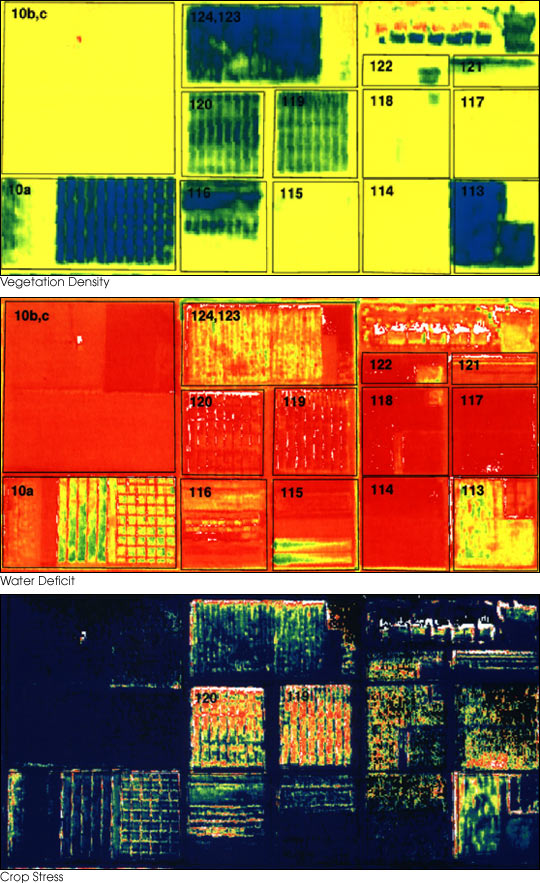
Precision agriculture uses sensors to tell farmers which parts of a field really need attention, so they can use fertilizer more efficiently. These false-color maps were created using the Daedalus sensor. Photo credit: NASA (https://commons.wikimedia.org/wiki/File:Daedelus_comparison,_remote_sensing_in_precision_farming.jpg#file)
In 2014, Lake Erie experienced an algae bloom so massive, and so toxic that for three days residents of Toledo were stuck using bottled water for everything from drinking to washing dishes. The toxins the algae produce are often fatal to pets and wildlife, and can cause human health problems, including skin rashes, gastrointestinal illness, liver damage, and even death. While scientists know exposure to high levels of algae pose health threats, little is known about what problems a lifetime of small doses could cause. A less toxic, but much larger bloom occurred in 2015, the largest Lake Erie has suffered since 2002, when scientists first started taking measurements. The proliferation of toxic algae was so bad, in fact, that it registered a 10.5 on the Lake Erie Severity Index. The scale used to only go from 0 to 10. A score of 5 on the scale, which measures the levels of algae, is already considered cause for concern.
These toxic algae, called cyanobacteria, are able to grow mainly because of influxes of fertilizer. Nitrogen and phosphorus from fertilizer runs off into streams, which then feed the algal blooms, especially in warm weather. The blooms not only make the water undrinkable but also deplete the water oxygen level and ruin the water’s aesthetic and recreational value.
Lake Erie is well publicized as an algae problem area, but it is hardly the only place suffering. The Willamette and Klamath Rivers in Oregon, the Gulf of Mexico, and the Chesapeake Bay all suffer from nutrient pollution. Toledo has a system for filtering out the algae and toxins, but the system works best if the algae bloom is caught early and using the filtration equipment costs thousands of dollars per day. To achieve real improvements, we need to think big picture and go back to the source.
Curtailing fertilizer use is hard, because modern agriculture is dependent on synthetic fertilizers. Fertilizers have dramatically increased the amount of food that can be produced on a given amount of land, and some people question whether agriculture that uses no synthetic fertilizer can feed the world. Considering the amount of food people waste in the US and Canada, it is worth questioning this logic. Also, since the phosphorus in artificial fertilizer has to be mined, we should reconsider our dependence on a non-renewable source of phosphorus when we could be using a renewable source like compost or manure. Still, the type of fertilizer is a minor concern as compared with the amounts. Today, farmers use twice as phosphorus fertilizer and five times as much fertilizer as they did in the 1960s. And, as every bloom reminds us, much of that fertilizer washes away before it can feed a plant.
Fortunately, there are answers. Studies from a test farm at the Kellogg Biological station show that a “conventional” farm, one that uses only synthetic fertilizer, loses half of its fertilizer to runoff. The same farm only lost a third that amount of its nutrients when cultivated organically, but saw a 20% drop in crop yield. However, a third plot that was grown primarily organically and built up nutrients using cover crops, but which also received small inputs of fertilizer to make up for deficits had almost exactly the same yield as the conventional plot and also lost less fertilizer. A blended approach could be a real help to both productivity and environmental health. Another study showed that adding more diversity to crop rotations could preserve soil nutrients.
Another important strategy involves “precision agriculture.” Farmers sometimes overuse fertilizer because keeping track of how much each part of a farm needs is time consuming. People sometimes just add more, preferring to add too much than too little. Precision agriculture refers to a bundle of techniques that use sensors to monitor various factors in soil like pH, moisture, and nutrient levels. Software organizes the data collected into color-coded maps, which tell farmers which parts of a field need what resources. The data can even be fed directly into a fertilizer spreader machine, which will apply just the right amount of fertilizer in each place.
Let’s be clear here: the phosphorus that runs off the field isn’t feeding anyone but the algae. Not only are we over-using and depleting our stores of phosphorus, we’re letting that excess phosphorus destroy another resource: our fresh water lakes. These new tools can protect Lake Erie, the Chesapeake, and other places we love and depend on. Whatever fertilizer we end up using, we should at least make sure it’s going where it should go: into our crops, not our water.